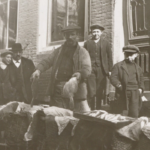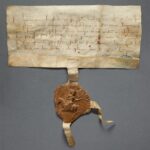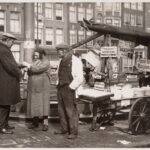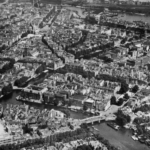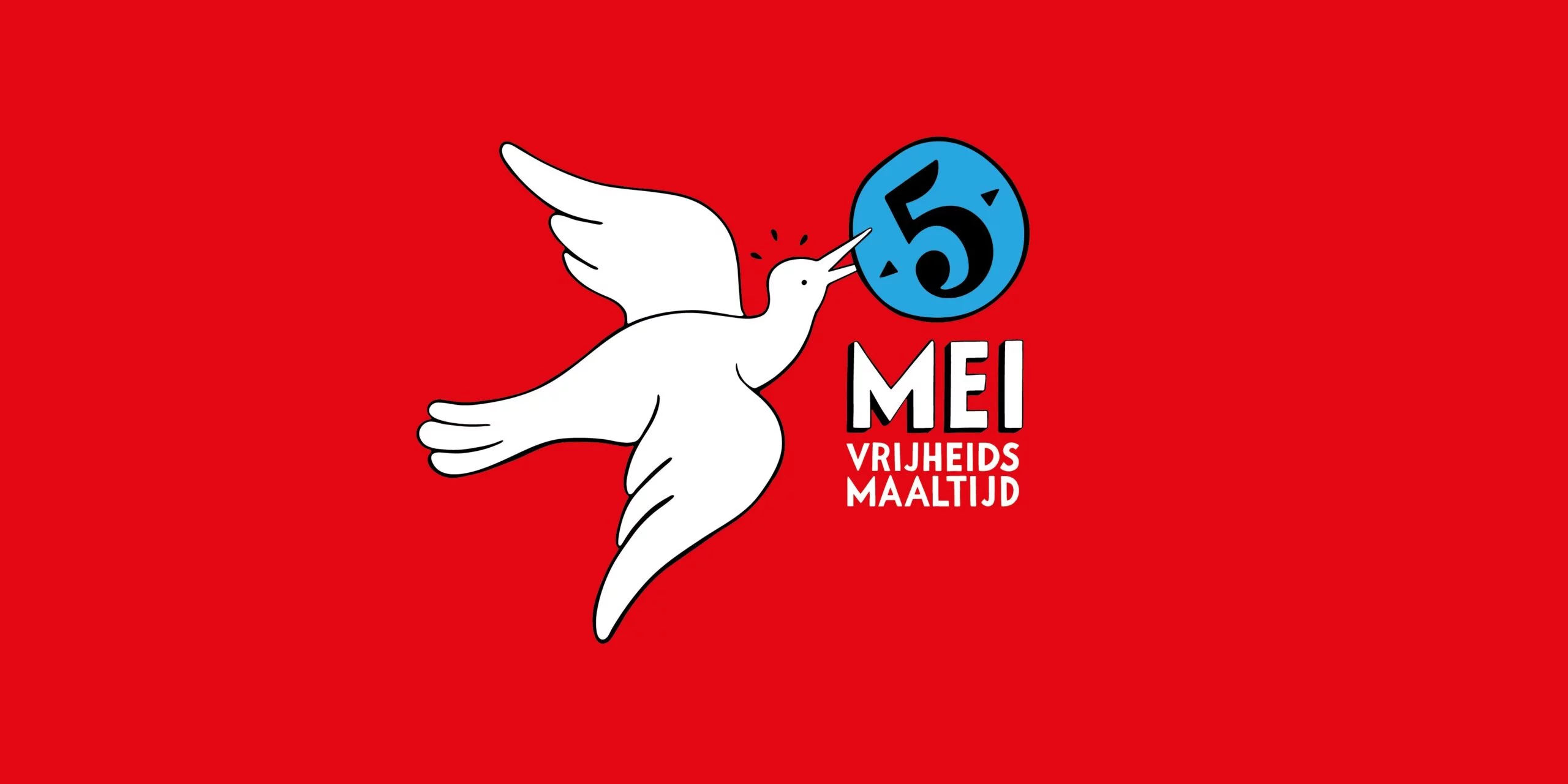
The following text is the transcript of my lecture, delivered during the an event in the context of our Liberation Day festivities on 5 May 2025, organized by student association L.A.N.X. together with Stadsdorp 7.
Good afternoon, my name is Onno Warns, and I’ve been asked to give a talk during this Freedom Lunch. Why I was asked to do so—I’ll come back to that in a moment.
Why do we commemorate?
It’s May 5th, and today we celebrate our freedom – last night in Wageningen, the Fire of Liberation was once again lit. Today, I want to reflect on the meaning of that freedom, and how it was experienced after the war.
Let me begin with a quote:
When Richard van Dam arrived in Tilburg, he was taken to a school together with Dutch citizens who had voluntarily worked in Germany. That caused great tension with the group of former political prisoners, among them Van Dam.
The commander of the school believed there should be mutual understanding because the Netherlands had just been liberated.
But I didn’t understand a thing of it and said: “Drop dead, man! I’m not going to share a room with guys who signed up voluntarily.” They didn’t get that. The man started yelling. There was no room… and things hadn’t exactly been pleasant in the Netherlands either, so we were supposed to be grateful we were even being helped!
– Michal Citroen, “U wordt door niemand verwacht” (“No One is Expecting You”)
May 4 and 5
Today, as we celebrate our freedom, I want to take a moment to think about remembrance.
Because I believe remembrance gives meaning to celebration.
Questions for the audience
Who among you usually attends a commemoration ceremony on May 4th?
Did that tradition come from your family?
And what do we commemorate?
Whom do we commemorate?
We’re here at a Freedom Lunch made possible in part by the 4 and 5 May Committee. On its website, the Committee writes:
Commemoration: Throughout the year, commemorations are held across the Netherlands to remember various groups of war victims. During the National Commemoration on May 4, we remember all victims together. Nearly every municipality holds its own ceremony.
Celebration: On May 5, we celebrate the liberation of the Netherlands in 1945 and the freedom we have enjoyed ever since. On this day we also reflect on the importance of freedom, democracy, and human rights.
Since when have I commemorated?
I still remember very clearly attending the May 4 commemoration at the Weteringcircuit as a child.
I have warm memories of it—of the silence.
And just last night, I was there again with my youngest daughter.
But since when have I commemorated my family?
Perhaps this is a good time to tell you a little more about myself.
I’m an Amsterdam native. My mother still lives about a kilometer from here.
I’m a historian—though for a long time I didn’t do much with that background.
But in recent years, I’ve started giving historical walking tours in Amsterdam.
One of those tours is through the Jewish Quarter—the old Jewish neighborhood around Waterlooplein.
Does everyone know the area I mean?
During that walk, I tell the story of the Jewish community in Amsterdam—how Jews first settled here in 1593, and how the community developed over the following 350 years.
And I tell the story of my great-aunt Tilly, who lived in the Plantage neighborhood when she was arrested.
So you may have guessed it already: I’m an Amsterdammer, a historian—and I’m also Jewish.
I wasn’t raised in a Jewish household—my father isn’t Jewish—but as I began to explore my family’s history, one thing led to another.
I say I’m “also Jewish” mostly because I realize that if it had been up to the Nazis, I wouldn’t be here.
That’s why remembering the war, the Shoah, and the nearly 102,000 murdered Dutch Jews is so deeply important to me.
Who do we remember?
When I asked just now, “Who do we remember on May 4th?”, I immediately heard: the Jewish victims. But that hasn’t always been the case.
At the first National Commemorations on Dam Square, only Dutch soldiers and resistance fighters who died in World War II were remembered. Jewish victims were not officially included until 1966, after the world had begun paying more attention to their fate—partly due to the widely broadcast trial of Adolf Eichmann, the so-called “architect” of the Holocaust.
Were the victims of the Shoah not commemorated earlier?
Within the Jewish community, there was an immediate postwar desire for a monument.
They wanted to place it on Jonas Daniel Meijerplein, the heart of the old Jewish quarter, between the German and Portuguese synagogues. But the Amsterdam city council rejected that idea: they wanted a monument to honor the only large-scale act of resistance against the persecution of Jews—the February Strike. That’s where De Dokwerker was placed.
The Jewish community was instead allowed to erect its own monument on Weesperplein: het Monument van Joodse Erkentelijkheid (1950) (the Monument of Jewish Gratitude). It was intended as a gesture of thanks from the Jewish community to Amsterdam and the Amsterdammers who had “helped them so well” during the war…
I think that monument reflects quite accurately what Jewish survivors found upon returning to the Netherlands after the war. Let me quote Michal Citroen again:
For Frank Keizer, liberation began on the train from [the concentration camp] Theresienstadt to Switzerland.
Somewhere along the way, one of the escorts told us to remove our yellow stars. That was an incredibly emotional moment, because we had worn them since 1942. Then we knew for sure we were headed in the right direction, although some didn’t believe it—some said: “This train goes straight to hell.”
What did I expect? Well, that we’d return to the house we left in 1943. The image of everything being unchanged. I had beautiful dreams of walking along the Coolsingel again, visiting the zoo, and reuniting with the friends I used to play cowboys and Indians with.
For months he stayed in Switzerland with a group of Dutch ex-prisoners. He went to school there, got new clothes, and—above all—had plenty to eat. His parents resumed their professions as doctor and dentist among the Dutch refugees. Two years later, when the family returned to the Netherlands, they were presented with the bill for their stay in Switzerland.
Dutch officials had kept detailed records of the cost per family member. The invoice came completely out of the blue. When we arrived back in the Netherlands in August, it was a huge letdown. We were brought to Eindhoven, to a Philips factory that had been turned into a reception center. They checked us for lice again, gave us new vaccinations—it felt like taking a giant step backwards. We weren’t treated as people returning from civilized Switzerland. I thought: God, another internment camp, more quarantine. Then we were sent to Rotterdam, to a shelter on the Heemraadssingel, because our home had been confiscated by the Germans and taken over by others.
The Monument of Jewish Gratitude was met with mixed feelings from the very beginning.
And, as the story of Frank Keizer illustrates, it fit all too well with the harsh and bureaucratic way postwar Dutch society and government treated the fewer than 40,000 Jews who had survived the war (out of 140,000 before it). Jewish survivors were charged for unpaid ground leases.
The Amsterdam transport company (GVB) sent invoices to the German authorities for unpaid transport fees—for the journeys that carried Jews from the Hollandsche Schouwburg to the train stations, and from there to Westerbork… and beyond.
There was little room for grief, because the country had to be rebuilt.
And there was certainly no room for the grief of the Jews, which reminded many Dutch citizens of their own not-so-heroic behavior during the war.
Holocaust Commemoration
In 1957, the Jewish community began its own Holocaust commemoration, held on 27 January—the day Auschwitz was liberated in 1945.
The first ceremonies took place at the Oosterbegraafplaats cemetery, where in 1977 Jan Wolkers’s mirrored monument Never Again Auschwitz was installed.
Since 1993, the commemoration has been held in the Wertheimpark, where the monument was relocated.
Today, Auschwitz has become synonymous with the Holocaust—and the Holocaust with Auschwitz.
But there were many more camps. Does anyone know how many?
… 1,078 concentration and extermination camps spread across Europe.
And now we have the Holocaust Names Memorial, bearing the names of the 102,000 Jews, Roma, and Sinti murdered during the Holocaust.
The monopoly of the Holocaust
That we remember the Holocaust on May 4 is not up for debate.
I would even say that the memory of the Holocaust has become all-encompassing—the ultimate moral reference point. To the extent that some believe you should never compare anything to it.
But I believe the opposite: we must compare everything to the Holocaust. We must remember that it was ordinary people who committed these crimes—and we must keep asking how it could happen, and how people became capable of it. Then, and still today. Again and again.
Every day, the most horrific massacres take place around the world—even genocide. The world watches. But what precedes them is always the same: racism, the erosion of the rule of law, the dehumanization of others…
None of these things make genocide inevitable, and history never repeats itself exactly the same way. But these are always the conditions under which such atrocities can occur again. We humans seem to learn very little—and are therefore doomed to make the same mistakes, over and over.
This celebration today may be symbolic. But it is precisely such (powerful) symbols that we—living comfortably here in the Netherlands—need in order to keep alive our awareness of, and our appreciation for, the value of freedom. And I believe that truly celebrating our freedom is only possible if we also take the time to remember.
